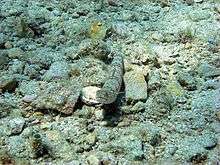Atlantic lizardfish
The Atlantic lizardfish (Synodus saurus), is a species of lizardfish that primarily lives in the Eastern Atlantic.
| Atlantic lizardfish | |
|---|---|
 | |
| Scientific classification | |
| Kingdom: | |
| Phylum: | |
| Class: | |
| Order: | |
| Family: | |
| Genus: | |
| Species: | S. saurus |
| Binomial name | |
| Synodus saurus | |
Information
The Atlantic lizardfish is known to be found in a marine environment within a general demersal depth range of about 400 meters. They are more specifically found in a depth range of about 20 meters. This species is native to a subtropical climate. The maximum recorded length of the Atlantic lizardfish as an unsexed male is about 40 centimeters or about 15.74 inches.[2] The distribution of this species occupies the areas of Eastern Atlantic, Morocco, Cape Verde, Azores, Mediterranean, Western Atlantic, Bermuda, Bahamas, Lesser Antilles, and the Leeward Islands.[3] This species is mainly known to be found in insular waters and on top of sandy or sand-rock bottoms.[2] The diet of the Atlantic lizardfish mainly includes other species of fish, but it is known to also feed occasionally on other animals. The Atlantic lizardfish can be found occupying waters around islands.[4] The Atlantic lizardfish keeps itself hidden and camouflaged by burrowing itself in the sand.[1] While it is burrowed in the sand, this species reveals his eyes so that it can watch its prey and pounce when food is available.[5]
Distribution
The distribution of the Atlantic lizardfish includes all of the following countries:
- Albania
- Algeria
- Anguilla
- Antigua
- Barbuda
- Bahamas
- Barbados;
- Bermuda
- Bosnia
- Herzegovina
- Cape Verde
- Croatia
- Cyprus
- Dominica
- Egypt
- France
- Gibraltar
- Greece
- Grenada
- Guadeloupe
- Guinea
- Israel
- Italy
- Lebanon
- Libya
- Malta
- Martinique
- Monaco
- Montserrat
- Morocco
- Saint Kitts
- Nevis
- Saint Lucia
- Saint Vincent
- Grenadines
- Slovenia
- Spain
- Syrian Arab Republic
- Trinidad
- Tobago
- Tunisia
- Turkey
- Virgin Islands
- British
- Virgin Islands
- United States[1]
References
- NatureServe (2013). "Synodus saurus". IUCN Red List of Threatened Species. 2013. Retrieved 15 December 2014.CS1 maint: ref=harv (link)
- "Synodus saurus (Linnaeus, 1758) Atlantic lizardfish". FishBase. Retrieved 14 June 2013.
- "Atlantic lizardfish". The Website of Everything. Retrieved 14 June 2013.
- "Fishes of the NE Atlantic and the Mediterranean Atlantic lizardfish (Synodus saurus)". Key to Nature. Retrieved 14 June 2013.
- "Atlantic Lizardfish Synodus saurus (Karl Linnaeus, 1758) Also Called : Bluestripe Lizardfish". Lurebook. Archived from the original on 15 June 2013. Retrieved 14 June 2013.
Notes
- Froese, Rainer and Pauly, Daniel, eds. (2012). "Synodus saurus" in FishBase. April 2012 version.
External links
- Photos of Atlantic lizardfish on Sealife Collection
